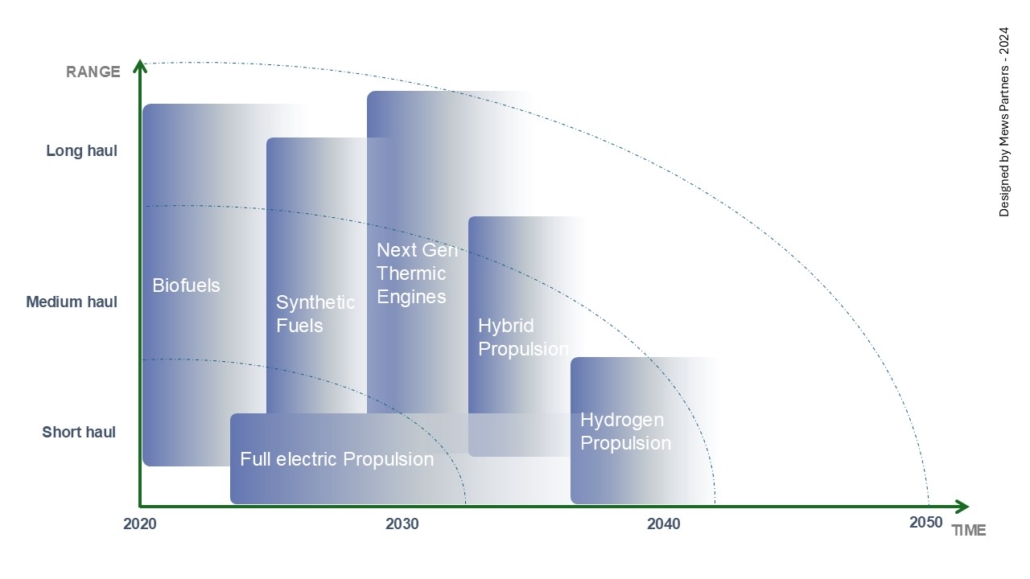Aviation is a significant contributor to global greenhouse gas (GHG) emissions, accounting for approximately 3.5% of the total. As the industry continues to grow, so does its environmental impact. To address this, ambitious targets have been set by the sector itself, like reducing aviation emissions to 500 million tonnes of CO2 equivalent (MtCO2e) by 2050, which is half of the levels recorded in 2005. Achieving this target is crucial for staying within the global carbon budget and mitigating climate change.
To meet these targets, the development of new, cleaner aircraft is essential. This will involve not only advancements in aircraft technology but also broader strategies and technological levers, such as sustainable aviation fuels, improved air traffic management, and enhanced operational efficiencies.
Designing the aircraft of tomorrow
The aviation industry stands at a crossroads, embarking on a journey to design new, sustainable aircraft powered by electric, hydrogen, or hybrid propulsion systems. These groundbreaking innovations are one of the levers to slash greenhouse gas (GHG) emissions and boost energy efficiency, addressing the pressing need for decarbonization in air travel.
Electric propulsion
Electric aircraft shine in their energy efficiency, converting a substantial portion of energy into propulsion. Emissions are minimal, contingent on the country’s electricity mix, and are non-existent during flight. However, the current state of battery technology imposes limitations on the range and autonomy of electric aircraft due to the hefty weight of batteries. The production of batteries demands significant quantities of raw materials, presenting supply chain challenges. Ensuring a stable and resilient supply of materials and technology within Europe is crucial for maintaining strategic independence.
Hydrogen propulsion
Hydrogen propulsion can be realized through fuel cells with electric motors or direct hydrogen combustion engines, the latter being less mature and currently less favoured. Hydrogen boasts excellent range and reduces refuelling times. While the production of hydrogen remains costly and dependent on the electricity mix, it produces no emissions during flight. Hydrogen propulsion technologies are still in their developmental stages. Significant investments are required in hydrogen production and distribution infrastructure. The overall energy efficiency of hydrogen systems needs enhancement. Hydrogen storage, whether gaseous or liquid, presents technical challenges. Competing demands for hydrogen across different sectors could limit its availability.
Hybrid propulsion and Sustainable Aviation Fuels
Hybrid propulsion combines electric and thermal propulsion to extend the range of aircraft compared to purely electric systems. Besides, hybrid technologies are more mature and closer to market readiness and existing airport infrastructure can support hybrid aircraft operations. Yet, emissions vary depending on the type of kerosene used.
The use Sustainable Aviation Fuels (SAFs) can help limit the in-flight GHG emissions of hybrid aircraft in the short term, as they can already be incorporated in conventional engines up until a 50% mix with standard kerosene. They can be split in two main categories: biofuels, which are made from biological resources, and synthetic fuels, such as Power-to-Liquid produced by combining hydrogen (generated from renewable electricity) with carbon dioxide captured from the air or industrial processes. Both categories have their own implications and range of solutions with diverse levels of maturity and decarbonisation power, but, in the end, the availability of SAFs may be limited due to competing demands with other industrial sectors and will inevitably depend on the mobilisation of producers to structure and industrialise the channel.
Diverse strategies, for varied timeframes and outcomes
Short term readiness
Certified light aircraft, such as those from Pipistrel, are already certified and in use.
Medium term readiness
Regional aircraft with fewer than 20 seats, including hybrid or fully electric aircraft, and potentially hydrogen-powered models, are being developed by companies like Voltaero (Hybrid), Aura Aero (Electric), and H55 (Hydrogen).
Long term readiness
Hydrogen-powered business jets, such as those from Beyond Aero, are on the horizon. Major players like Airbus are exploring hydrogen-powered commercial aircraft (ZeroE) and electric commercial aircraft (eAction). Yet, companies like Universal Hydrogen, which aimed to retrofit regional ATR aircraft with hydrogen propulsion, have faced significant challenges, leading to its recent closure. This highlights the tremendous challenges to design a new sustainable aircraft.
In addition to technological breakthroughs aiming at moving away from conventional jet fuels, other innovations to create next generation thermic engines e.g. from turboprop to open-rotor, may help reach significant gains in energy efficiency of the engines and may play a role in the transition towards greener aircraft. To get a clearer view of the technological outlooks presented before, we propose the following mapping to position them given their readiness and adapted range between short, medium and long-haul flights.

While these technological advancements are promising and offer a glimpse into a more sustainable future for aviation, many uncertainties remain, particularly regarding their widespread availability and implementation. Despite these uncertainties, the urgency of the ecological challenge demands immediate and concrete action. The aviation industry cannot afford to wait for perfect solutions to emerge. So, how to address the pressing need for sustainability? As often, there are many areas of optimization to be found in the current practices of manufacturers and airlines.
A wide range of levers to combine towards a more sustainable aviation.
Although creating the aircraft of tomorrow is a key element of the aviation industry’s decarbonization strategy, it is indeed far from being the sole measure needed to meet environmental objectives. By optimizing operations, improving aircraft designs, implementing regulatory measures, and encouraging individual behavioral changes, the industry can collectively cut its greenhouse gas emissions and lastingly promote environmental responsibility.
Technological and Operational Advances
One significant approach to decarbonize the aviation sector involves optimizing operations. This includes improving the load factor to maximize in-flight efficiency and implementing eco-friendly taxiing methods, known as green taxiing. Additionally, optimizing ground and in-flight performance is crucial. This could be achieved by selecting destinations, optimising trajectories to reduce non-CO2 emissions, and utilizing formation flying techniques to save fuel.
A critical area is design optimization. Beyond propulsion systems, enhancing energy efficiency has been a priority since the first jet airliners were introduced in the 1950s, leading to an 80% gain in fuel efficiency over 60 years. To continue this trend, aircraft must be made lighter using new materials and their aerodynamics improved with innovative wing aerofoils and aero shapes.
Fleet renewal is also essential. Adopting the best available technology progressively is more realistic than a sudden overhaul. Airlines typically replace aircraft when maintenance costs exceed the cost of new ones. However, significant investments are required, and current technology does not meet environmental targets yet. Moreover, production bottlenecks exist, with Airbus having an 8 to 10-year backlog for single-aisle aircraft.
Socio-Political Strategies
Regulations play a vital role in reducing emissions. Implementing taxes on tickets and airlines, setting goals to limit or reduce air traffic, and promoting alternatives like trains are all effective strategies. Isolated initiatives by airports and airlines can also make a difference. For example, some airports may refuse expansion or limit the number of flight slots, as seen with Schiphol. Airlines and travel agencies might also change their business models to promote longer or closer trips.
Individual behavioural changes are another important factor. The movement of flight shaming, known as Flygskam, encourages responsible flying and has gained traction in some regions.
All these levers can help the aviation sector approach its environmental targets. While upstream supply chain decarbonisation could have a marginal impact, drastic regulations like lifetime flight quotas can seem extreme for the time being but might become an option one day. A rough overview of these actions, classified according to their emission reduction potential and their maturity and acceptability levels, proposed below can provide valuable insights. It is important to note that carbon offsetting is deliberately omitted here as it is not a true solution, only a last resort that shifts the problem elsewhere.

Decarbonising the aviation sector is undoubtedly one of the most challenging tasks in the short term. Achieving sustainability goals will require activating multiple levers, including the adoption of SAFs, the development of new aircraft, and the optimization of operations. As promising as those solutions can be, a significant degree of sobriety in air travel practices should eventually be essential to meet these ambitious targets.












